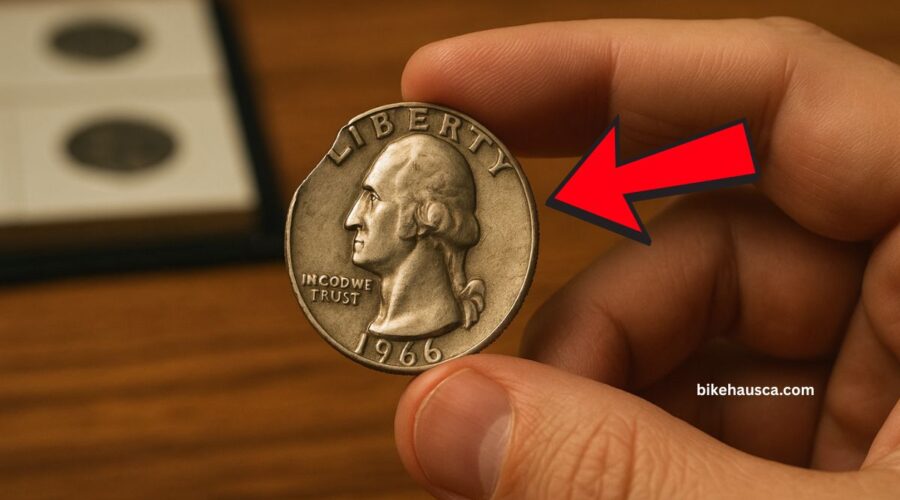Could Your 1966 Quarter Be Worth $20 Million? Rare Error Coin Details Revealed!
Every now and then, an ordinary-looking coin turns out to be worth a fortune. Such is the intrigue around the 1966 Washington Quarter, which has sparked excitement among collectors due to certain rare error versions that could be worth thousands—and rumors swirling about a possible $20 million price tag.
While the exact claim of a $20 million valuation is likely exaggerated, the truth is that some rare 1966 quarters have fetched high prices due to their unique errors and minting anomalies.
So, before you dismiss the change in your pocket, here’s everything you need to know about the 1966 error quarter and how to identify one that may be worth serious money.
A Quick Overview of the 1966 Washington Quarter
- Metal Composition: 75% copper and 25% nickel (no silver)
- Mint Marks: No mint marks were used in 1966
- Mintage: Over 821 million quarters were minted in 1966
- Weight: Approximately 5.67 grams
- Edge: Reeded (grooved)
Because of its high mintage, most 1966 quarters are common. However, rare error coins stand out—and that’s where the value lies.
What Makes a 1966 Quarter Valuable?
Not all 1966 quarters are valuable, but certain error coins and high-grade Special Mint Set (SMS) coins can command impressive premiums. Key characteristics that drive up the value include:
- Minting errors
- Misstrikes
- Wrong planchet usage
- Off-center or double dies
- High-grade conditions (MS67 or higher)
Let’s explore these features in detail.
Types of Valuable 1966 Quarter Errors
| Error Type | Description | Estimated Value |
|---|---|---|
| Doubled Die Reverse | Doubling on the reverse lettering like “QUARTER DOLLAR” | Up to $900 |
| Off-Center Strike | Part of the design is missing due to misalignment during minting | $50 – $150 |
| Clipped Planchet | A portion of the coin’s edge is missing due to cutting error | $30 – $100 |
| Wrong Planchet | Coin struck on a dime, nickel, or foreign coin planchet | $100 – $450+ |
| Broadstrike Error | Coin struck outside retaining collar—appears wider or stretched | $30 – $80 |
| High-Grade SMS Coin | Special Mint Set coin in near-perfect condition (MS67+) | $200 – $800 |
How to Identify a Rare 1966 Quarter
To find out if you have a valuable 1966 quarter, start by examining:
- Lettering and Design: Look closely at both sides using a magnifying glass for any doubling.
- Edge and Shape: Odd shapes or flat edges could signal a broadstrike or clipped planchet.
- Size and Weight: A coin struck on the wrong planchet may weigh less or more than the standard 5.67 grams.
- Mint Luster and Finish: If you find an unusually shiny or frosted quarter from 1966, it could be an SMS coin, often more valuable in high grades.
Special Mint Set (SMS) Coins of 1966
In 1966, the U.S. Mint released Special Mint Sets instead of traditional proof sets. These coins had better-than-average finishes—somewhere between business strike and proof.
Why SMS Coins Matter:
- SMS coins don’t have a mint mark
- They feature a satin or semi-proof-like finish
- In top condition (MS67 or MS68), they can sell for hundreds of dollars
While not errors, these coins are more collectible and command higher prices.
While most 1966 quarters are worth just 25 cents, a select few with rare mint errors or exceptional grading can sell for hundreds or even thousands of dollars. The excitement around a possible $20 million valuation, although speculative, highlights the thrill of coin collecting—because sometimes, a simple pocket change could hold a hidden treasure.
So next time you come across a 1966 quarter, don’t dismiss it too quickly. Check for those key error signs—you just might be holding a coin worth a small fortune.
FAQs
Is it true a 1966 quarter is worth $20 million?
There is no confirmed case of a 1966 quarter selling for $20 million. However, rare error coins can be worth hundreds to thousands of dollars, depending on their rarity and condition.
How do I know if I have a valuable 1966 error coin?
Inspect the coin carefully for doubling, clipped edges, or off-center strikes. A scale or caliper can help detect weight and size anomalies that suggest rare planchet errors.
Should I get my 1966 quarter professionally appraised?
If your coin shows any unique characteristics or is in exceptional condition, it’s smart to have it graded by a professional service like PCGS or NGC to determine its true market value.


Leave a Reply